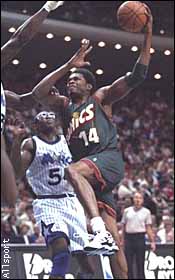
ALSO SEE
By Phil Green
ESPNET SportsZone
CLEVELAND -- Every party has its outcasts, and at this weekend's NBA All-Star party, you'll find them at the 3-point shootout. Big men Sam Perkins and Terry Mills are among the participants in a competition generally dominated by guards and swingmen.
 |
|
Sam Perkins is a threat both in the post and behind the 3-point line.
|
They might not be expected to win, but the 6-foot-10 Mills and 6-foot-9 Perkins bring the necessary credentials. Mills ranks third in the league in 3-point percentage (45.8) and fourth with 110 treys made this season. Last month, Perkins tied an NBA single-game record when he hit all eight 3-point attempts against Toronto, and on the year he's connected on 40.8 percent of his long-range shots.
But Dale Elli, the league's all-time leader in 3-pointers and the 1989 champion of this contest, wonders about the event's legitimacy.
"The line's so close anybody can make it," Ellis said. "I thought it was ridiculous that they put it in so close in the first place. There used to be a time when you stepped outside the line and it felt like it was impossible to make it. But you've got all kinds of guys taking the shots now and making it."
Regardless of Ellis' sentiments, the line is closer. More people can hit the trey. And Mills and Perkins will be shooting to become the tallest winners of a contest which has traditionally given the league's long-range bombing guards their half-hour of glory.
Three-time winner Larry Bird (6-foot-9), is the tallest player to ever win. But as with most of his accomplishments, Bird was the exception rather than the rule. Since Bird's consecutive victories in the competition's first three years, Dennis Scott and Glen Rice have been the only players taller than 6-foot-7 to reach the finals. And nobody ever accused either of those guys of being major board bangers.
 |
|
Mills
|
The main disadvantage for Mills and Perkins will be their release time. During games, they both play either the power forward or center spot and get wide-open looks at the basket when either their defender drifts into the middle of the defense or they're guarded by shorter players on the perimeter.
As a result, they get plenty of time to shoot the ball and don't possess as quick of a release as their shorter counterparts who often must shoot quickly over a charging shot-blocker. In a contest against a 60-second clock, that patient delivery could hurt Perkins' and Mills' chances.
"I did it twice in Seattle and got them all off," Perkins said of a recent practice. "Now, I'm going to have to rush it just a little. I'm going against the clock."
The two "giants" will have one major advantage, though. Many of the guards like Legler and Steve Kerr take actual jumpshots -- bending their legs and leaping off the ground as they fire. When you're trying to hit the most shots possible in 60 seconds, that gets tiring. Mills and Perkins don't need to jump; they just bend their knees and let it rip.
But Legler doesn't think that advantage will be enough for either Mills or Perkins to stake a clam to the championship.
"Guys who maybe are a little more catch-and-shoot, even if they are jump-shooters, it helps them because they're used to getting shots off quick," he said. "The ball's halfway to the rim and you're grabbing for the next ball. That's a little different than in a game."
And in this skills competition, rather than a regular game, size offers no advantage.
![]()